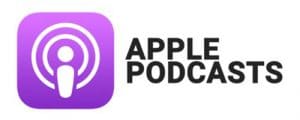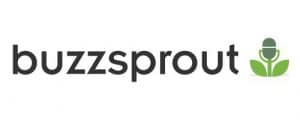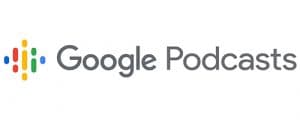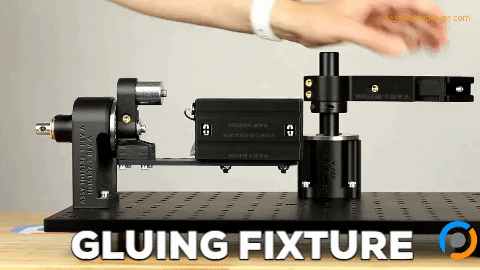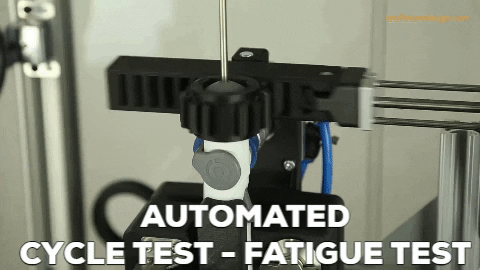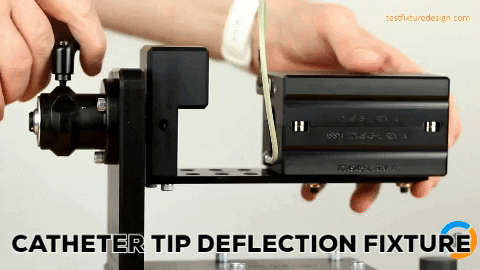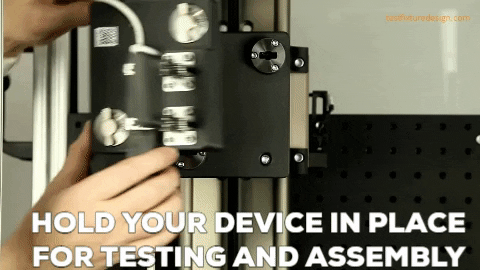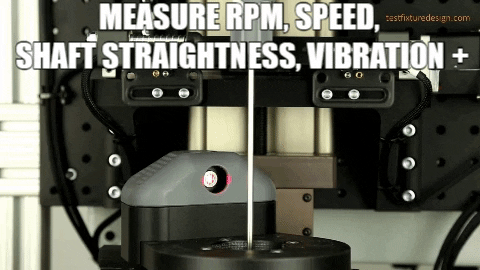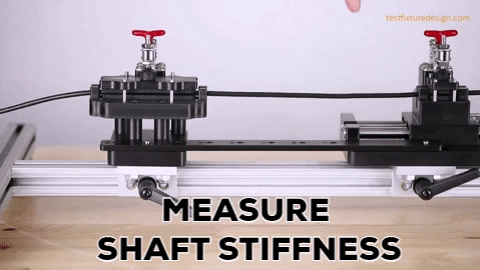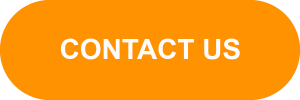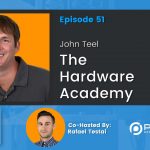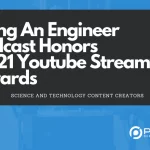Robert States Solving Failures and the “Been There Done That” Engineering Strategy
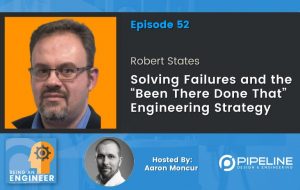
Who is Robert States?
Robert States shares how he started as a plastics engineer and his experiences working with multinational corporations. You should check out the part where he shares his experiences that led to him joining his current company. In addition, we also tackle what his life has been like now, which he describes as being highly focused on driving the careers of his team members.
Robert holds a bachelor’s degree in plastics engineering and an MBA from Penn state. Meanwhile, Robert is a principal at Stress Engineering Services, where he and his team provide comprehensive design, analysis, and testing services to industries from Plastics to Packaging, Materials to Testing, Medical to Pharmaceutical, Pipelines to Power, and Measurements to Forensics.
EXPAND TO VIEW EPISODE TRANSCRIPTION
SUMMARY KEYWORDS
people, problem, companies, engineering, model, work, clients, failure, device, engineer, plastics, run, design, drive, services, talked, process, industry, folks, team
SPEAKERS
Rafael Testai, Presenter, Aaron Moncur, Robert States
Presenter 00:00
The being an engineer podcast is a repository for industry knowledge and a tool through which engineers learn about and connect with relevant companies, technologies, people, resources and opportunities. Enjoy the show.
Robert States 00:16
You know as an outsider looking in we’re an engineering services company but inside these four walls where people development company
Aaron Moncur 00:36
Hello, and welcome to another episode of The being an engineer podcast. Our guest today is Robert States, who holds a bachelor’s degree in plastics engineering, and an MBA from Penn State. Robert is a principal at stress engineering services where he and his team provide comprehensive design analysis and testing services to industries from plastics to packaging materials to testing medical to pharmaceutical pipelines to power and measurements to forensics. Robert, thank you so much for joining us today.
Robert States 01:11
Thank you for having me.
Aaron Moncur 01:12
Well, how did you decide to become an engineer,
Robert States 01:16
I was always liked math, and solving problems. And in Penn State, the campus I went to was close to my house and my high school. So I went up there I took classes when I was in high school. And I just asked which degree paint the most when you graduated? And I could choose that’s how I chose plastics.
Aaron Moncur 01:36
Is that right? Which degree within engineering or just which degree?
Robert States 01:40
Yeah, what also paid the most I think across that campus, I went to allow Penn State Erie, which is a you know, a sub campus from Maine. And it has the highest salaries for starting salaries for graduate.
Aaron Moncur 01:52
Interesting. Now, did it ever? Were you ever worried that? Yeah, maybe this is going to have the highest salary. But what if I don’t like it? Was that ever a concern?
Robert States 02:02
No. You will not even know what a plastics engineer did. I had no idea I had no. I originally thought I wanted to be an architect. And they had programs when I was in high school where you can go shadow architects and I realized that you have to have an artistic flair to do that. Well, and I don’t have that gene,
Aaron Moncur 02:21
as many mechanical engineers lack. Yes. So what does a plastics engineer do?
Robert States 02:27
You know, the focus was, I would say a split between mechanical design processing in some chemistry and I would say was that mix pulled together. And it’s an Engineering Technology degree. So it’s more hands on, it’s more applied. And so you you you really ran a lot of stuff in the labs, you ran equipment, you ran test equipment, you ran processing equipment. You learned a lot about design, you learned a lot about simulation. So it was quite an eclectic group of talent and everybody graduates I got a job offer as a sophomore, the job market was so hot in the 90s that people were offering a job as a sophomore.
Aaron Moncur 03:08
Wow, incredible. I mean, these days, you don’t see degrees specifically for plastics engineering, you see mechanical engineering, you see electrical engineering, chemical engineering. It was was plastics engineering, kind of a rare degree even back then.
Robert States 03:23
You know, yeah, it wasn’t the most common there’s a handful of schools. UMass, Ferris State. You know, obviously, Penn State, there’s a lot of polymer science kind of schools. You go for polymer science, but you don’t in about doing it in, in this in the form of more design, more processing. Those are rare combination.
Aaron Moncur 03:46
Yeah. Okay. Well, eventually you wound up at the company for whom you work now stress engineering services. Can you tell us a little bit about how did you get there?
Robert States 03:58
I had. So I worked for two large multinationals before joining stress. And I worked for the first one I worked for I work for two key people, both of them left, in one came, went to another company where I went there first. So my first job out of school is for Procter and Gamble. And the guy originally worked for left I went to Rubbermaid vice president of our mace I went up to Rubbermaid and worked there for a handful years and the other guy worked for came to stress engineering and and I watched the business cycles. And I realized that in working for big corporations, there’s a lot of upsides to that, but also, they’re, you know, with time, you know, the company is changing a lot and their need for different skills changes. And so sometimes it’s not your choice if you’re going to be there in the long term. And I just said, Well, I’m not going to let that happen to me. So I was attracted to the services model because I really have, you know, for the sake of discussion, I have 50 employers which you know, I just have a you have a pool of 50 clients, and so, you know, as long as you keep on doing a great A job for them and looking out for them and making sure you’re providing value, you will have a job the rest of your life. So I’ve learned the art of really understanding value for our clients. And, and I’ve really just adopted the services mindset. And I really, it’s a gift that I got from a company that allows you a total freedom. I’m in year 18, and my job has been unscripted for 16 years.
Aaron Moncur 05:26
What does a day in the life look like for you right now? Or is it just completely different every day?
Robert States 05:32
A huge variety. The you are well, you know, I’m in a role now we’re really supporting a lot of the folks that are coming up in the ranks, you know, what’s, what’s interesting about this business model is it’s not a zero sum game. My goal is that the folks that are that work for me is they all become my peer become my partner. So I focus every day, on really driving the careers of the individuals here, you know, as an outsider looking in, we’re an engineering services company. But inside these four walls were people development company. And so I spent a lot of time on a variety of projects. And what’s interesting is, when you’re a physics based organization, you’re almost industry agnostic, because the physics are identical in all these industries. And so you will work in multiple industries in any given day, I work in oil and gas, I work in consumer products, I work in med device, and I work at pharmaceutical all before lunch, then that happens. And so it’s a huge variety of it, there’s never a boring day, I can guarantee you that.
Aaron Moncur 06:36
It’s interesting to hear you talking about the variety when I talked to my team, and we’re a services company as well. And when I asked them, What do you like about working in pipeline, one of the most common answers is the variety of work that they get to do right, at a big corporation, you might be doing the same thing every day, you know, month after month, maybe even year after year. But in a services organization, like you said, you have 50 different customers or more. And there’s always something different to do, which, for me anyways, is very gratifying. Now, you’ve been there at SCS for for 17 years and change. That’s that’s a fairly long time to stay at one company. What has kept you there all these years?
Robert States 07:15
Well, I’m an owner. And so if I want to complain about my boss, or there’s really no one to complain, yeah, and so it is a model currently, that’s based on a partnership. So when you get promoted, you buy in and the buy in was more than the value of my last house. Right? You know, so it’s a significant thing. Now, I, I think we’re heading towards where partial lease operating towards probably, you know, maybe a model of 100% ESOP or something like that, but the, but you’re truly an owner, you’re truly an owner. And in that part I really like right, and it’s not that for the power or whatever else, but the freedom, I really do what I just want to do, I find my lane, you know, if you read about anybody that’s successful, you go watch any commencement speech of a successful person, any Hall of Fame speech of anybody in any sports, and they always have this consistent theme. I stayed in my lane, and I did it really well. And that’s what I encourage everybody here as stress to do, that’s what I do. If I’m good at it, I’m gonna do it. And before you know, I’m here every day at seven, and sometimes I don’t leave to seven. And I don’t even realize it, you know, because you’re just doing what you like.
Aaron Moncur 08:28
What advice can you give to listeners who might not have as much freedom as you do, but who wants to have that kind of role? Where they find what they do really well? And they just keep doing that thing? Is that something that can be done in most companies to some extent? Or do you really have to find a special organization, maybe a services organization, similar distress where they can do that
Robert States 08:51
bias? I would think that only a handful people actually do that in a corporation. And, you know, if you get to a fellow role after 30 years of working somewhere, maybe, but I would say, if you don’t control your future, someone else will. And you know, and in for me, I spent a lot of time with the folks here thinking about what is your lane? What do you do? Well, and let’s promote that.
Aaron Moncur 09:18
Yeah. Over those 17 years, I’m sure you’ve encountered many, many projects, can you share what has been one of the most technically challenging projects that you and your team has solved without going into any confidential information of course and, and what was the process that you followed to solve that problem?
Robert States 09:38
Um, you know, we we do a lot in the men device space with campus and, and I, you know, I have a client that in the, in the, we’ll call the structural heartspace, where they had had multiple capitalise on the same product over five or six years. I’m sorry to interrupt
Aaron Moncur 09:57
kappa corrective and preventive I can’t remember what the last eight stands for.
Robert States 10:02
Yes. So it’s generally a process that they follow where they identify the root cause and what they’re going to do to address that. And so that’s that that’s a term popular in well, probably many industries, but popular in the in the med device space, right. So. So corrective action and preventative action, some something along those lines there. And this client was struggling with this, they had sent it to multiple firms. And we went through the typical process of what we thought cause a problem. And we came up with the same results that everybody else came up with, right. And so I came in, because it wrecks my brain. So I come in, well, first, I always go talk to the rest of the brain trust in the building. I mean, I have 100 PhDs for colleagues, I’m like, I work at a university except where we get stuff done. And, and, in, so you know, I talked to all of them. And you know, and sometimes they say, you just have to go out there. And, you know, play with the assemblies and see what’s really going on. And so it basically they were solving bonding some punk components together and was breaking the two big. And I went out in the lab, and I was trying to recreate this problem. And you know, basically a solvent, bonding them and then putting them under tensile right away and seeing if I can cause it to fail. And, after a period of time, probably about two hours out there, I finally ran across a combination and actually couldn’t make it happen. So I started designing experiments around that and seeing if I can reproduce it, and I could, then I went back to the client, and I asked them about process changes that they’ve done and what their control strategy was. And lo and behold, I stumbled on what actually really happened. And you know, this is one of those things with a little little bit of adhesive is good, a lot is better. Well, in this case, here a lot caused a chemical attack and was causing a failure on the tube. And they had changed out. They were running some, you know, Kaizen events or whatever, and they were trying to speed up and cut their cycle times down on manufacturing. So they usually let those parts sit for a period of time before they would put them in the packaging and put a sustained strain on the tube. And so you go and you’re able to backtrack, saying I know this is the failure mode, this is the only way I can get this to fail. You’ve done this with several other companies. And this is the only way I can get this to fail. Where would this occur? And we tracked down in the process, well, that would occur, we addressed it and the problem went away. I have a client for life.
Aaron Moncur 12:39
Absolutely. Man, what a great feeling that must have been.
Robert States 12:43
Yeah, I mean, you know, if you just want to sit behind a computer all day long, you’re not going to solve some of these problems.
Aaron Moncur 12:50
Well, what is your process for product development? Like at SCS? What are what are your teams doing there that other firms should consider doing?
Robert States 13:00
You know, I have, you know, one of the one of the advantages that we have is that we become a clearinghouse industry for problem. So third of our business is just dealing with problems. And we see the same problems over and over and over again, and it gives us a huge competitive advantage. Because in this building, here, we have 100 people we burn through 650 projects a year. Wow. Okay, so you see an awful lot, some are really big, some are really small. But you know, so you can imagine to under those projects are just dealing with that situation. And what you want on your team is not someone who’s read about it or seen it, but done it in. So I like to sit way early on in the process with the maybe the systems engineer with the program manager and say, this is where you’re gonna have trouble here, here. And here. Because we just see, we call material failure logic models, we see the same combination of events lead to failure, and it’s not about being critical and say, they can’t make this happen. But it’s about making sure that you have an engineered solution that will be robust. And so one, you know, we follow the same process that everybody else follows from the FDA for med device in all in the in the waterfall process. But I think the real advantages is Steding way up front in telling them where you probably need to spend extra effort. So I’d say that’s number one. Number two is we’re strong components of using predictive analysis and designing your part we can design the for the design the manufacturer in the US, so we will do advanced simulations on all those in if you don’t understand it, you can’t simulate it and get it right. If something does slip through the cracks. You can always go back and interrogate the model. And those are some you know that you know, I don’t think that that’s as strong in the men device and pharma space, as it is in the Consumer Price. Next space, right? So the consumer product space has been doing this for a long time. Because they’re they’re concerned themselves with scale up from zero to a billion or zero to 100 million men device. Folks don’t concern themselves with that. So they do a lot of build test fail cycles. And you know, there’s better ways to go about doing that. Yeah.
Aaron Moncur 15:21
You talked about some of these common areas that you’ve been able to see as patterns, because you’ve seen so many of them, are there a few of these common areas that lead to failures that you can share?
Robert States 15:35
Yeah, absolutely. The when they passed the Affordable Care Act, what that said was, is that if you get an infection in a hospital, the hospital is not going to be reimbursed for the additional incremental cost to treat that patient. So what you saw was cleaning protocols were changed within clinical environments, and they became more aggressive with the cleaning. Well, that caused environmental stress cracking on very common materials used in the med device space. And you know, one of the most common materials that everybody knows about is polycarbonate. And polycarbonate is bulletproof. Right. And the dirty little secret about it is is it can take a strong impact, but you put a little bit of load on there for a long enough period of time, it will break. And it’ll be accelerated by things such as cleaners, the cleaners will accelerate that. So we saw a lot of Catholics go through and they’re starting to wind down the industry is not getting ahead of that problem. But you we just saw a rash of those problems coming through the organization that’s very common. And as part of that, you also saw that they’re driving up the IPX rating. So you’ll see it on your iPhone, it has an IPX rating, it tells you how much water you can expose, whether you can go down a meter, or whether you can put it in a shower, or whatever it is. And so you see these systems being sealed up. So the systems then with these batteries inside are getting hotter, and they’re aging the parts and they’re failing earlier. You know, so you’re seeing these kinds of failure modes, right, and they’re very common in the marketplace. In they still happen a lot today. And so, you know, there’s an example of one that that’s very, very common. Yeah, is is really how sterilization affects materials. People still run into a lot of problems with sterilization is very, very common to run into sterilization problems, and they have a negative impact on the material.
Aaron Moncur 17:33
Those are great examples. And I can see how if you weren’t privy to seeing those so frequently. I mean, it could take a team, you know, weeks or months or longer to figure out what’s really going on, but because you guys have been able to see the same problems. So often, we probably a lot faster at diagnosing those then than other organizations.
Robert States 17:51
Yeah, if I can add to that engineers are, they often have a lot of pride and never, they don’t want to call for help. Right? You know, so you realize, you know, that we get the phone call, and they’ve been struggling for six months. And you know, now, you know, if I’m presenting in person, or now you’re doing it with, you know, teams or whatever. And I say, ask them, Well, does it look like this, and I’ll bring it up on the screen their failure mode, because they’ll just describe it to me. And I’ll know within a handful of minutes, probably what is driving that problem? Because I’ve been there and done that before. And it’s really about the remediation, I say, does it look like this? And they go, how do you know? Well, it’s my job to know. And so it looks like this, and, and they’re trying to get their bearings on why it’s happening. And I start talking to him about how we’re going to fix it. And they’re like, Oh, wow. And again, you know, one of our you know, we have lots of clients. And it’s not unusual that our first interaction with a client is they got a problem. And then they realize that, hey, you know, there’s value for you to add here. Most of our clients, we deal with the top 20 Min, device, pharma can surprise companies, these, they all have tremendous resources. But what they don’t have access to is all those tremendous resources on a dime in so we can just give to a breakdown in there. They bring you in, they want you as part of their team, and we just help them drive through and get the product development done.
Aaron Moncur 19:12
Yeah, I can attest to that. Have you worked with several large medical device companies, ourselves? They are, in general much more concerned with getting something done quickly than they are with how much it costs. To point of course,
Robert States 19:26
yeah, that’d be their, you know, your, you know, you set up your rate structure commensurate with the value that you give to your clients. And so, you know, so you know, when when a third of your business is the emergency room, you know, what that means is is that we have to have all these resources. All these people are getting W twos from stress engineering, we have all these labs. They’re there to be used on a moment’s notice based on that need.
Aaron Moncur 19:51
Well, that’s a great segue into my next question, what are some tactics were best practices that the best product development firms out there the best engineering services companies out there follow to ensure that they remain profitable.
Robert States 20:06
Yeah. So device development is broad in long and requires you to do 1000 different things. It also requires people to who have done technical things 1000 times. All right. And so those, so it’s not about pride, but recognizing who’s been there and done that before. I mean, what time All I care about who on my teams is like, who’s been there and done this before. So we can drive this through to those that recognize that do that? Well, and we see a lot of I mean, we have certain clients, certain med device companies that we will all know, some of them are highly vertically integrated internally, and they build those systems. Other ones have, like a skeleton crew, where they fill the rest with either contractors or services companies. They’re both they’re both trying to accomplish the same tasks in a different ways. But really, you want those folks that have been there and done that before. You know, what’s very common, though, you go into design review, and they generally bring the person has been around for 30 years in the back, and they sit there and you’re, you’re presenting all this stuff, and you’re all happy about it. And they they say to comments, and I’ll get shut down at a moment’s notice. Right. And, and then I mean, a lot of us have been there before? Well, let’s not get to that point. Let’s make sure the team that people on the team have been there and done that before. And I refer back to the systems in general engineering role when you’re developing your requirements. And you’re also seeing through how am I going to verify these requirements? How am I going to validate this product? And you’re thinking through all that upfront, and and those that manage that better? tend to have less problems? And, you know, I think this because I can run down the reasons why failures occur, but I’ll walk through it, or there’s four big items that drive failures in product development.
Aaron Moncur 21:56
Are you going to tell us what those four are? Or hold us in suspense?
Robert States 22:00
Oh, I’ll go through those. You know, so I spent a lot of time after you know, you get a phone call and you go, you know, go work with a client to get them across the finish line. And, you know, maybe they had some problems along the way. And I’ll ask, you know, how did you get here? It doesn’t show up on an FMEA doesn’t show up on a file tree doesn’t show up anywhere? The simple answer is almost always I didn’t know I needed to know that. Number one. All right. Number two is key stakeholders talking past each other. i There’s a push the push the development down into the supply chain. And when you look at failures, you know, if I have a failure, and I show it to design personal time, it’s a design problem, I take it to a materials person, they’ll tell me as a material problem. I take it to a manufacturing person, it was made wrong. And then my more favorite one recently is I take a human factors and it’s a user. And you know, well, who’s right? Well, the fact is they’re all right. But if you have an injection molded part, and it’s failing, what I see is is they go to the person who made the part and said, Well, you’re an injection molder, you should understand mechanics and materials and human factors. They don’t they’re really good at manufacturing, you should rely on them for manufacturing. But they’ll ask them, do you know about plastics? And they’ll say, Yes, we do. And they go, Well, that’s fantastic. Because we have a plastic part. And we need help. And they’re all talking past each other. And they don’t realize the limitations of their conversation. That is the number two driver of failures. Number three, I see the reinvention of the wheel every day. All right, you know, there’s this constant need to reinvent the wheel. And they’re going up these learning curves. That’s why you want someone who’s already been up the learning curve. They go up the learning curve, and you’re like, Hey, listen, that problem has been solved over here. And the fourth reason, often very controversial, is rapid prototyping. Rapid Prototyping gives you overcome overconfidence too early. Especially when he showed to someone who doesn’t know a lot about development. They go it’s there, just go. And I see that a lot. So there’s an over reliance on rapid prototypes to build confidence and that we can move faster. And, you know, and I see that a lot too. So those are often if I had to boil it down to the four drivers that often drive a lot of failures in you know, and this comes from looking. I mean, I like to do failure. I always I always tell people my nickname is Winston Wolf. Now, for those that don’t know who Mr. Wolf is, that’s the cleanup guy from Pulp Fiction, you know, 30 minutes away, be there and 10 Right, you know, you’re so you know, you you see you see a lot of problems all the time. I in any you started going? Yep, they did that. Yep, they did that they did that, you know, my favorite thing is is that, you know, I, I know how much it cost to do the work that they needed to get done that they should have done, you know, six months ago. But at times it was probably a $5,000 task that could have saved them a million dollars. And I see that a lot.
Aaron Moncur 25:17
Wow, that’s incredible. Ouch. All right. Well, this is a good place to take a quick pause and share with the listeners that Team pipeline.us is where you can learn more about how we help medical device and other product engineering or manufacturing teams, develop turnkey equipment, custom fixtures and automated machines to characterize, inspect, assemble, manufacture and perform verification testing on your devices. We’re speaking with Robert States today, Robert, you have personally investigated and interacted with over 30 different services firms, from engineering to marketing to product development. Are there any common threads or patterns that you’ve seen amongst them all?
Robert States 26:02
The most successful people are the ones that learn how to develop strong relationships with their clients and understand their clients needs. The if you want to go sell your capabilities, you know, if you want to go do with capabilities presentation, you’re going to narrow your scope if you want to provide a solution to the clients that will grow. So those that really capture that, that essence of that they have the most amount of success, right? The other thing is, is they stay in their lane. And they stop telling the world they can do everything, you know, well, I once did that, you know, 30 years ago, I you know, I can probably dust off the book and figure that out. It’s like, hey, if that’s a part of a bigger scope of work great, but you go be that first interaction with a client not a good idea.
Aaron Moncur 26:45
Well, it goes back to the learning curve that you’re talking about, right? All of a sudden, you have to climb this giant curve in order to get the job done.
Robert States 26:53
Yeah, listen, during the peak of COVID, the unemployment rate for an engineer was 3%. Right? There’s no shortage of need in the marketplace for engineers, be who you are.
Aaron Moncur 27:07
Well said, Well, what what tools are gaining traction in the development phase of a device or a piece of equipment? What tools are you seeing commonly being used these days?
Robert States 27:23
You know, in the consumer products industry was on the forefront of using predictive now. Because they were trying to drive out costs, and they build automated tools, known back 30 years ago, they gotta have an app for your iPhone at this point for this. But it’s interesting in Aerospace is only done this way. offshore oil wells are only done this way. It’s all done with predictive analysis, you can’t prototype that stuff. But what you find is the med device base is like lagging that industry by literally 20 plus years, right? You will see them do it for APNIC implants and heart valves, because again, that’s hard to prototype. But the rest of it is not fully accepted in the marketplace, to the extent it is in other industries. And that’s a huge opportunity. And the FDA recognized that and the FDA is pushing on us to drive competitiveness in the United States. And so they provided guidelines a handful years ago on how to do this, you know, I’ve had opportunities to go visit the FDA. And I’ve seen some of their data where they go off and run, you know, round robins off testing and analyses and they get the data back. And they showed me some of the variability it was highly variable. And so that’s the problem that the industry struggles with is how do you use these tools and know that you have a regular regulatorily grade solution? And so that’s what’s coming out. And so, you know, you should expect to see this grow. Right, you know, the pharmaceutical industry is do this for the drug development. I mean, they’re, they have just loads and loads of PhDs are really deep. But I said, Well, why don’t you go use us on your Med device? Nope, on our drug delivery system? Nope. You know, that’s, that’s someone else’s problem. So you know, they recognize the value, but they won’t invest in it. So that that creates the opportunity for a lot of other companies in the marketplace. So you’re gonna, you’re gonna see that to continue to grow in terms of supporting development, and in those that use predictive modeling, you know, such as FTA, or CFD, they might use them the development phase, and it sits on the harddrive collecting dust for the rest of its life. And what you should expect to see those models will have life through the product lifecycle, where you’re going to be running digital twins of the manufacturing process and the use. You compare that against the predictive models. And you’re going to be able to use that to drive quality and drive long term reliability.
Aaron Moncur 29:47
Can you talk a little bit more about the digital twins? So what are digital twins and how are they used?
Robert States 29:52
Yeah, so if you have enough people listening to this, they’ll say I get the definition of ROM so it’s used by a lot of people in a lot of different ways. But In the context, and I’m just going to strive it is, is that if I, if I was putting a plunger into a glass syringe, and if I’m able to take a picture of that plunger, I know the profile and I know the ID because I can measure the ID somewhere online, for a given syringe, I should know that I should be able to highly predict the force to insert that plunger into the switch. Okay. And today, it’s all done statistically. And, you know, it’s it actually failures get through, I can tell you all about as I see them, and stuff gets through, and they’re buying led components, stock components from companies like West or like, dot while or BD, right, everybody does that it’s a very smart move, it’s a great thing to do, all in favor of it. But you know, but they have all those three companies, for instance, are trying to satisfy you know, 50, other pharma companies who all have their own requirements, everybody’s trying to figure that out. But if I know that, that force to insert that, that plunger in there should be I’m making up numbers here, you know, half a pound, right? And, and I know that force should be that in and I know the dimensions are correct. So I’ve done a model and calculated on the edge, right, so I calculated that I measure these things, I should be able to put this together, it should be half a pound, and it comes out, then it’s three quarters of a pound, go. If there’s no silicone isation on there, maybe something happened there. And you should be able to do that digital twin there and know what that force should be in because you may be measured in line online Metrology is something that’s coming along. And you’re able to do that calculation because you have the predictive model in the background, you’ve build the regulatory grade models. And you can see these things, you could check against that they might all be dimensionally correct, they go all the way through the system yet, if you were going to go look at the forced activate that syringe, it’s going to be high, and maybe not acceptable. And so you should be able to do all that forensic exam on that device before it leaves the line. And that’s how I would use digital.
Aaron Moncur 32:08
So restating that digital twins are, when you’re performing a test on a physical component, and you get whatever result you get based on that physically performed test, then you compare it against your predictive model your your FPGA or your CFD, and you compare those results. And if they’re significantly different, then that gives you pause, and you say, Hold on, something’s not matching up. Not sure if it’s on the digital twin side, or on the physical side, but something’s not matching up. Let’s figure this out. Is that accurate?
Robert States 32:43
Yeah, and I can take it a step further we deal if you’re familiar with a bathtub, reliability curves, you know, reliability gets better once, you know, initial phases, after you launch it steady, then reliability gets out of control again, you know, you know, at some point in time as things wear out, and so everybody understands how to handle early on reliability issues, right? Everybody has that built in their system dealing with it. I mean, I know there’s better ways, and some companies are better at than others. But the one that all of a sudden product has been in the market for 10 years, and everything’s in spec, but all of a sudden, they have problems. Right? We see those two, probably about one a quarter. And you go, what happened? What happened? How do I find that problem? So you know, you go Wait, a pack Expo is going on? And you go there, and all these people have these signs, say, industry 4.0? And you go up and and say, What does this mean to you? And they’re like, Oh, well, we can provide you eight terabytes of data a day. Okay, what am I gonna do with that? And, and so I think the real opportunity here is I talked about the digital twin is that you should know what the force should be. Right? And actually, your your thing is, is that if it doesn’t match, you either interrogate the model, you interrogate the part. So if I have a statistics based model, there’s a lot of information companies out there, like SAS and others, who will, you know, do the data science, and they’re statistically looking at that process. And my thing is this when the when the the physics based model and the statistics based model diverge. That’s when the, that’s when you get those late stage reliability issues, you know, late product life, realize, okay, and you can predict those and remember, what’s the number one reason why I have a failure? I didn’t know I needed to know that. So there was something in that physics based model that didn’t capture that behavior. And it prompts you to go look for it. It prompts you to go look for it in you know, so this anticipate systems don’t work until you made a million products. I’m just making up numbers here, but you don’t know until you reach some sort of steady state. When you see from day one with a physics based model. You can provide confidence that that product is good, and you’re going to learn about what’s really driving your reliability. And you can predict when it’s going to be problematic sometime down the road. And I really think That’s a true opportunity in the marketplace. And I know companies are trying to figure this out, I talked to them, they all have interest, the bigger and I go talk to an individual unit, I’ll talk to quality regulatory, sustaining engineering, folks, r&d, folks, operations, folks are on board, but none of them have the political capital make it happen. So it really has to happen from the top down. And I would say, the industry is in flux, and how that’s gonna happen. I just know of case studies that we’re involved with, or this is happening. But you know, this is coming.
Aaron Moncur 35:33
We’ve been talking about failure a lot during this this episode. Share with me, how does organizational structure drive failure?
Robert States 35:45
Yeah, there, there’s a couple couple things there, if you don’t have, if you are highly vertically integrated, and you have a relatively young staff, you don’t have enough people there to have seen enough. Right, you have to have that mix. And so if you have an organization that regularly burns through people, and there’s companies like that we all run across them, there is no one that’s been there and done that, that holds that tribal knowledge. Right. And so you really need access to that tribal knowledge. One way or the other, though, if you’re if your structure is to be highly vertically integrated, and you have a relatively inexperienced staff, you know, even if you have a handful of experienced people on there, they can’t capture it, all right, you need to be diversified there, as opposed to a model where you rely heavily on expertise on the outside, you know, and I always, I always tell people, I’m never going to understand their products or their customers as well as they do. But you know, outside people can provide an equal perspective, if they’ve been there and done that, you know, I’ve done I’ve worked on, you know, 50 different platforms or drug delivery systems. So, you know, bring me number 51, there’s probably not something that I haven’t seen before, right? Right, oh, bring the right, they don’t need to run the project, you’ll only need them for a small percentage of them, help them help let them help you identify where the problems are going to be, then accept that help. And it will go a long way. So, you know, sometimes you have, you know, big corporate entities, I can tell you that, you know, we get phone calls all the time, where, again, the capabilities of some of these large multinationals is huge their share price lose more than the value of stress engineering every day on the stock market, okay. But they can’t motivate their colleagues to help them. And, and so, you know, you need to have a model that provides a lot of freedom to the people to get the job done. Right. And then teach them about what right is. And so I would say, you know, I see how the different organizations have. And here’s the net result. You know, it’s, I can just tell you, if you’re buying services, it’s a lot cheaper to prevent it, then deal with it later. They never asked me how much it cost to fix it. But they’re always asking for detailed proposals to help them up front. And hey, I get it. You know, we’re in a capitalist society, this is what we’re going to do. But you know, I can just tell you, I guarantee you, it’s a lot lower cost to do it upfront.
Aaron Moncur 38:20
To put the time and to do it right now. Right? Yeah. What was the saying? It’s, there’s, there’s always time to, or there’s never time to do it. Right. But there’s always time to do it again. Yes. All right. Well, I think we’ll wrap up here in just a few minutes. I’ve got one or two more questions for you, what are one of the biggest one or two of the biggest challenges that you face at work?
Robert States 38:51
Um, you know, it’s important to keep clients happy. And you know, you have no throttle on whether you’re going to get four phone calls today. 10, or one or zero. And so you’re always trying to manage that. And that’s it. That is probably the most difficult part is just manage that. And because it’s key that you keep them all happy that they come back in. So I’d say that that’s probably the, you know, the biggest challenge. The other one is, is the in this aspect of this role, is there’s a, there’s a business development aspect that that there’s a there’s a high spirit of entrepreneurship here. That’s very hard for engineers. You know, I went to I’ve never taken entrepreneur class in college, I said, I’ll never do this. I’ll never do this. You know, I lead a lot of the business development activities. So you know, so it’s, it’s that that’s a that’s a difficult I mean, I live for now. I love it, but that’s hard for a lot of people.
Aaron Moncur 39:56
Yeah. Yeah, that’s hard for me to wrap my head around. as well, because that’s the part I love the entrepreneurial part, but not everyone’s built that way. And actually, that’s a good thing, right? The world doesn’t need everyone to be an entrepreneur.
Robert States 40:09
Yeah, I mean, I segment our folks from I draw a bell curve distribution. On one end, you have really what I call the SME squared or the fellow. On the other end, you have really divisionary in you know, and then I have a spectrum across that where I broke it up into six segments. And I really spent a lot of time with the individuals and figuring out what are you? Are you being in the middle? Are you on the left? Are you on the right doesn’t? You know, the answers are all correct. I mean, what’s important to stress is that all of them are important. All of them, there’s, there’s there’s no greater among them. And I arrived, okay, this is your lane. This is this is what good looks like this is how we’re going to develop you and your career. And you know, we want you to go pursue this and love what you do.
Aaron Moncur 40:54
Yeah. Okay. Well, before we wrap up here, is there anything else that we should have talked about that we haven’t yet?
Robert States 41:04
No, I mean, I can just tell you that it product development doesn’t have to be as hard as it is that a lot of people are experiencing and right. So you know, be open to other ideas in you should explore them and go in find people you can trust the the number one piece of advice. I told you my job’s unscripted here, but I always tell people, surround yourself with people who have been there before and listen to it.
Aaron Moncur 41:31
I love it. All right. Well, Robert, thank you so much for joining me today. I really appreciate you spending some time on on the podcast. Oh, this was
Robert States 41:40
Great. I really appreciate it.
Aaron Moncur 41:45
I’m Aaron Moncur, founder of pipeline design and engineering. If you liked what you heard today, please share the episode. To learn how your team can leverage our team’s expertise developing turnkey equipment, custom fixtures and automated machines and with product design, visit us at Team pipeline.us Thanks for listening.
Rafael Testai 42:16
Your valued listener We kindly ask that you help us get to 105 Star podcast reviews in the platform of your choice for a chance to win a $50 amazon giftcard send a screenshot of your five star podcast review to podcast at Team pipeline that us you will find that email address in the description of the show notes
About Being An Engineer
The Being an Engineer podcast is a repository for industry knowledge and a tool through which engineers learn about and connect with relevant companies, technologies, people resources, and opportunities. We feature successful mechanical engineers and interview engineers who are passionate about their work and who made a great impact on the engineering community.
The Being An Engineer podcast is brought to you by Pipeline Design & Engineering. Pipeline partners with medical & other device engineering teams who need turnkey equipment such as cycle test machines, custom test fixtures, automation equipment, assembly jigs, inspection stations and more. You can find us on the web at www.teampipeline.us.
We hope you enjoyed this episode of the Being an Engineer Podcast.
Help us rank as the #1 engineering podcast on Apple and Spotify by leaving a review for us.
You can find us under the category: mechanical engineering podcast on Apple Podcasts.
Being an Engineer podcast is a go-to resource and podcast for engineering students on Spotify, too.
Aaron Moncur and Rafael Testai love hearing from their listeners, so feel free to email us, connect on Facebook, Twitter, Instagram, and subscribe on Apple Podcast and Spotify!
\
You’ve read this far! Therefore, it’s time to turn your headphones up and listen now to this episode to learn all these. Above all, don’t forget to tell your friends who might like this too!

